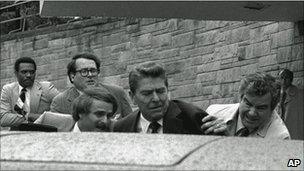Ronald Reagan: 30 years since assassination attempt
- Published
ABC News footage of the moment President Reagan was shot in March, 1981
On 30 March 1981, just 69 days into his presidency, Ronald Reagan was shot and wounded outside the Washington Hilton by John Hinckley Jr in an assassination attempt. President Reagan suffered a punctured lung in the shooting, but survived. Three others were also wounded.
That day, 30 years ago, two actions saved Reagan's life. The president's reaction to the attack which almost killed him may have made his presidency.
For Secret Service agent Jerry Parr, it started as a pretty regular day.
"Rawhide" - the codename the Service gave this 40th president of the United States - was giving a speech at the Washington Hilton, a venue that was just a few minutes' drive from the White House, and had been used dozens of times by presidents past.
After the speech, Reagan walked out of the VIP entrance and toward his car. To his left there were gathered a few reporters, some camera crews, some bystanders.
By today's standard the security was astonishingly lax; anyone, it seemed, could get within metres of the president. One of those who did was John Hinckley Jr, armed and with a desire to make an impression that would last.
'Get him out'
A short distance from his car, Reagan turned to his left, raised his arm and waved to the small crowd.
"When we get about five or six feet from the car," remembers Jerry Parr, "I hear two shots, quick, bang bang, and then bang, bang, bang, bang."

The quick actions of former Secret Service agent Jerry Parr probably saved President Reagan's life
Mr Parr did not stop to think, he just reacted to the sound, almost throwing the president into the car and landing heavily on top of him, covering Reagan with his body in case there was a second gunman waiting to take another shot through the open car door.
On the tape of the shooting, which was caught on film by the waiting news crews, you can hear voices shouting "Get him out! Go! Go! Get him out!" amongst the mayhem. Reagan's bullet-proof car sped off.
Inside, Mr Parr ran his hands around Reagan's body but failed to find any wound. The president complained of chest pain and said that perhaps he had bruised or broken a rib when Mr Parr had landed on him in the car immediately after the shooting.
Over the Secret Service radio, the word went out: "Rawhide is OK, Rawhide is OK." And the decision was made to take the president back to the White House - the safest place in Washington.
But Mr Parr, with Reagan in the back of the car, started having doubts. At the city's Dupont Circle he asked the president how he was feeling.
"He said he was doing OK, 'but I think I've cut the inside of my mouth'. And he started spitting up this bright red blood, real frothy, and I took one look at it and I looked at his mouth and I saw that it was ashen grey, little bit of blue around the lips.
"And I just took a quick decision, I'm taking you to the hospital, and he said 'OK'."
Entry wound
That act probably saved the president's life. Reagan managed to walk unaided from the car into George Washington University Hospital but then collapsed.

Jerry Parr, right, was among Secret Service agents who pushed Reagan into his waiting limousine
After several examinations, an entry wound was found: a bullet had ricocheted off the road, slipped between the body of his car and its open door, and slipped into him 6in (15cm) below his left armpit. It came to rest in his left lung.
White House press secretary James Brady, a secret service agent and a District of Columbia police officer were also wounded, leaving Mr Brady permanently disabled.
Outside the hospital all was confusion. On a live news broadcast, ABC's Frank Reynolds assured viewers that Reagan had not been shot, only to be told that he had been hit.
"My God!" he cried out on air. "The president was hit… he is in stable condition… all this information… The president WAS hit."
In hospital, Reagan's blood pressure was lifted and stabilised, but blood kept filling his lung, suggesting heavy internal bleeding. An operation was planned.
His wife, Nancy came to see him. "Honey," quipped Reagan, "I forgot to duck."
'Genuine moments'
The surgical team assembled, but before they started the president looked at them. "I hope you are all Republicans," he said, mock-gravely.
After the surgery the gags kept coming. And this, believes Del Quentin Wilber, who has written a minute-by-minute chronicle of the day, is what lifted Reagan's presidency out of the mere normal.

President Reagan had a genuine connection with the American people
"The last four presidents who have been shot have all died, and here he is cracking jokes and laughing at death. The American people love that.
"Those kinds of things, they don't get cemented in a person's mind through polling or slick advertising or message management. It's through the genuine moments that the public experiences with the leader.
"And this was the moment for Ronald Reagan. The American people had separated the man from his politics."
Reagan went on to serve two full terms - the first president in almost three difficult decades to do so - and when he left office, he did so with sky-high approval ratings.
Just a few weeks ago, what would have been Reagan's 100th birthday was commemorated with a slew of rosy retrospectives. But the legend that was celebrated was arguably born 30 years ago today.